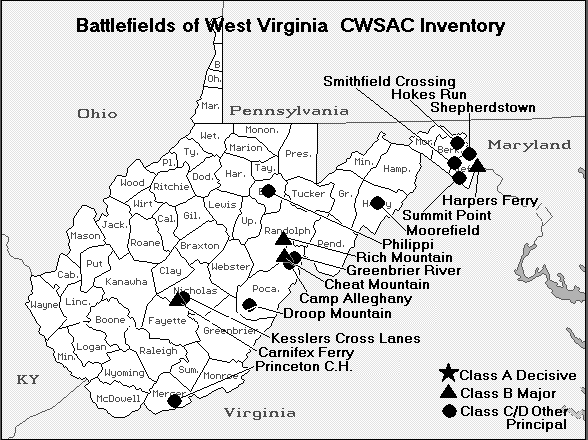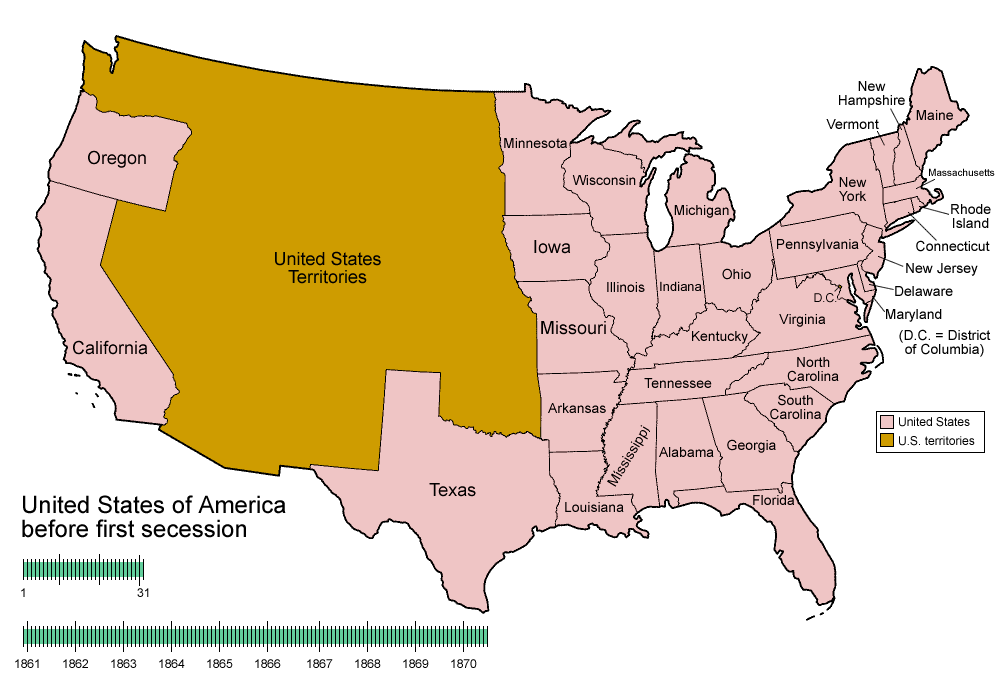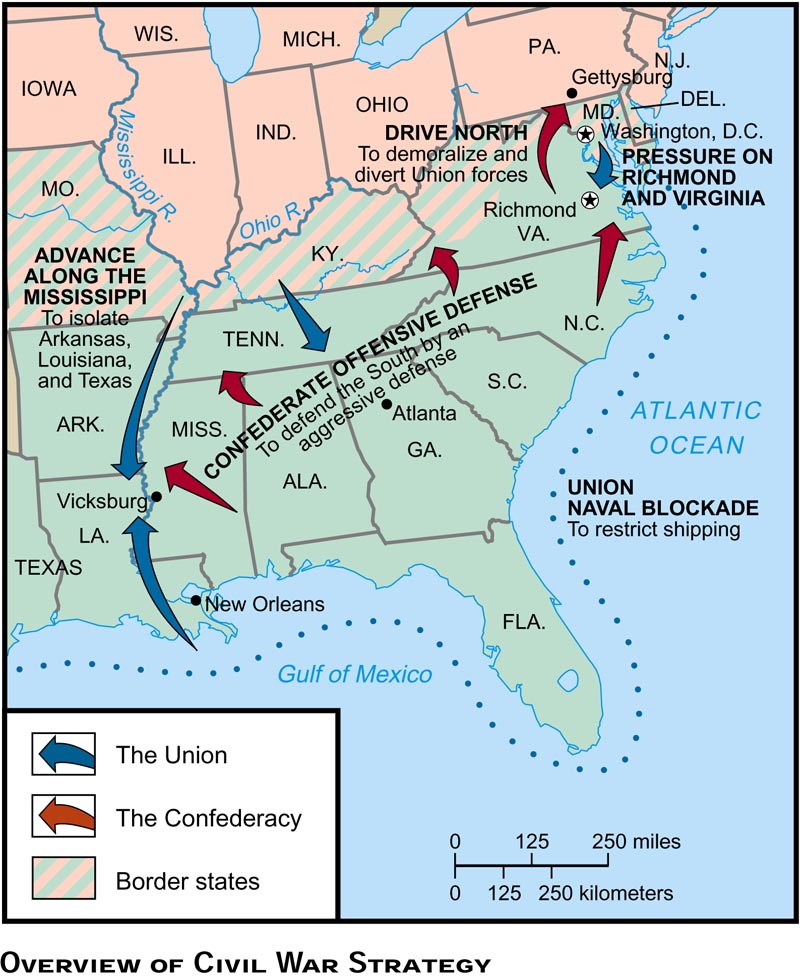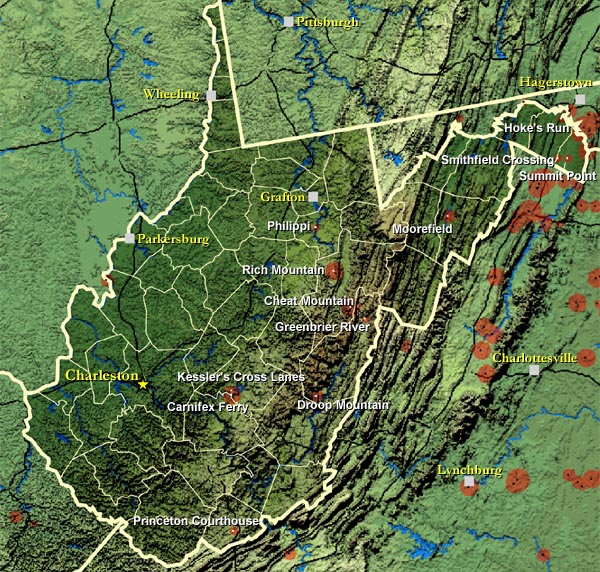|
West Virginia and the American Civil War
Introduction: West Virginia became a state by breaking
away, or seceding, from Virginia during the American Civil War (1861-1865). The new state was admitted to the
Union on June 20, 1863, and was a key Civil War Border State. West Virginia was the only state to form by seceding from a Confederate state,
and was one of only two states formed during the American Civil War (the other one being Nevada, which separated from Utah
Territory). Bordering Pennsylvania, Kentucky, Ohio and Maryland, West Virginia was strategically important to both the North
and South.
The area which became West Virginia
furnished about an equal number of soldiers to the Union and Confederate armies. Each army recruited approximately 22,000–25,000,
for a total of 44,000--50,000 for the state. (Depending on source, the total varies.)
| West Virginia Civil War History Map |

|
| West Virginia Civil War Battlefield Map |
West Virginia was the battlefield for the following principal Civil War
battles: Battle of Camp Alleghany; Battle of Carnifex Ferry; Battle of Cheat Mountain; Battle of Droop Mountain; Battle of
Greenbrier River; Battle of Harpers Ferry; Battle of Hoke's Run; Battle of Kessler's Cross Lanes; Battle of Moorefield; Battle of Philippi; Battle of Princeton Courthouse; Battle of Rich Mountain; Battle of Shepherdstown; Battle of Smithfield Crossing; and Battle of Summit Point.*
A Divided State: In the summer of 1861, Union troops under General George McClellan drove off Confederate
troops under General Robert E. Lee. This essentially freed Unionists in the northwestern counties of Virginia to form their
own government as a result of the Wheeling Convention. After Lee's departure, western Virginia continued to be a target of
Confederate raids, even after the creation of the new state in 1863. These actions focused both on supplying the Confederate
Army with provisions as well as attacking the vital Baltimore and Ohio Railroad that
linked the northeast with the midwest, as exemplified in the Jones-Imboden Raid. Guerrilla warfare also gripped the new state,
especially in the Allegheny Mountain counties to the east, where loyalties were much more divided than in the Unionist northwest
part of the state. See also West Virginia in the American Civil War: A History.
| West Virginia Civil War Map |

|
| Civil War West Virginia Map |
Civil War: In 1861, as the United States itself became
massively divided over regional issues, leading to the American Civil War (1861–1865), the western regions of Virginia
split with the eastern portion politically, and the two were never reconciled as a single state again. In 1863, the western
region was admitted to the Union as a new separate state, initially planned to be named the State of Kanawha, but ultimately
named West Virginia. See also Virginia Civil War History.
West Virginia is one of two U.S. states
formed during the American Civil War (1861–1865), along with Nevada, and is the only state to form by
seceding from a Confederate state. It was originally part of the British Virginia Colony (1607–1776) and the
western part of the state of Virginia (1776–1863), whose population became
sharply divided over the issue of secession from the Union and in the separation from Virginia, formalized by admittance to
the Union as a new state in 1863. With statehood, West Virginia became one of the Civil War Border States. West Virginia,
furthermore, profoundly affected by its mountainous terrain, spectacular river valleys, and rich natural resources, was
ripe for Guerrilla war.
Despite its central location and disputed
territory, West Virginia suffered comparatively little. Early in the war, Thomas J. "Stonewall" Jackson led the Great Train
Raid of 1861, which resulted in the capture of several locomotives and rolling stock of the Baltimore and Ohio Railroad. Jackson
later led his men in what became known as the Romney Expedition, an unsuccessful attempt to firmly establish Confederate
control over western Virginia. In a series of relatively small battles, McClellan's forces gained possession of the greater
part of the territory in the summer of 1861. Later that year Robert E. Lee attempted to retake western Virginia but was ultimately
defeated by a far smaller Union force at the Battle of Cheat Mountain. A key part of the Union strategy in West Virginia for
the rest of the war was to keep the vital Baltimore and Ohio Railroad open as a major supply and troop transportation route.
On June 20, 1861, delegates from the trans-Allegheny counties of Virginia
(who had voted overwhelmingly against secession) met at the Second Wheeling Convention and declared that because Richmond
had seceded all state offices had been vacated. The Convention stepped into the role of filling these state offices calling
itself the Restored State of Virginia.
| West Virginia Civil War Border State Map |

|
| Border State West Virginia Civil War History Map |
A continuing and important mission was to protect the vast supply warehouses
and munitions factories at Harpers Ferry. However, the town fell to Stonewall Jackson during early days of the Maryland Campaign,
and the surrender of its Federal garrison was the largest capture of U.S. Army troops until World War II nearly eighty years
later. With Lee's retreat to Virginia following the Battle of Antietam, Union forces again occupied Harpers Ferry. The Maryland
Campaign concluded in what became West Virginia with the Battle of Shepherdstown.
In 1863, Brig. Gen. John D. Imboden, with 5,000 Confederates, overran a
considerable portion of the state and tore up sections of the B&O Railroad. Bands of guerrillas burned and plundered in
some sections, and were not entirely suppressed until after the war was ended.
On June 20, 1863, the newly proclaimed state of West Virginia was admitted
to the Union.
A Confederate brigade of cavalry under antebellum U.S. Congressman Albert
G. Jenkins saw considerable action during the Gettysburg Campaign, as well as other major campaigns. A number of West Virginia
regiments were distinguished for their war records, including the 7th West Virginia Infantry which assaulted the Sunken Road
at Antietam and rushed onto Cemetery Hill in the twilight at the Battle of Gettysburg to help push back the famed Louisiana
Tigers. The 3rd West Virginia Cavalry also fought well at Gettysburg as a part of John Buford's veteran cavalry division that
defended McPherson's Ridge on the first day of the battle.
By early 1863 Union efforts in West Virginia were going badly. Unionists
were losing confidence in the Wheeling government to protect them, and with the approaching dismemberment of Virginia into
two states guerrilla activity increased in an effort to prevent organization of county governments. By 1864 some stability
had been achieved in some central counties, but guerrilla activity was never effectively countered. Union forces that were
needed elsewhere were tied down in what many soldiers considered a backwater of the war. But Federal forces could not afford
to ignore any rebel territory, particularly one so close to the Ohio River.
As late as January, 1865, Gov. Arthur I. Boreman complained of large scale
guerrilla activity as far north as Harrison and Marion counties. In one last, brazen act of the guerrilla war, McNeill's Rangers
of Hardy County kidnapped Generals George Crook and Benjamin F. Kelley from behind Union lines and delivered them as prisoners
of war to Richmond. The Confederate surrender at Appomattox finally brought an end to guerrilla war in West Virginia. Slavery
was officially abolished February 3, 1865. See also West Virginia in the American Civil War: A History.
| West Virginia Civil War Map |

|
| West Virginia Civil War Battlefield Map |
Analysis: During the American Civil War, West Virginia
suffered comparatively little. Union General George B. McClellan's forces gained possession of the greater part of the territory
in the summer of 1861. Following Confederate General Robert E. Lee's defeat at Cheat Mountain in the same year, Union supremacy
in western Virginia was never again seriously challenged. In 1863, General John D. Imboden, with 5,000 Confederates, overran
a considerable portion of the state. Bands of guerrillas burned and plundered in some sections, and were not entirely suppressed
until after the war was ended. Estimates of the numbers of soldiers from the state, Union and Confederate, have varied widely,
but recent studies have placed the numbers about equal, from 22,000-25,000 each. The low vote turnout for the statehood referendum
was due to many factors. On June 19, 1861, the Wheeling convention enacted a bill entitled "Ordinance to Authorize the Apprehending
of Suspicious Persons in Time of War" which stated that anyone who supported Richmond or the Confederacy "shall be deemed...subjects
or citizens of a foreign State or power at war with the United States." Many private citizens were arrested by Federal authorities
at the request of Wheeling and interred in prison camps, most notably Camp Chase in Columbus, Ohio. Camp Chase Civil Prisoners.
Soldiers were also stationed at the polls to discourage secessionists and their supporters. In addition, a large portion of
the state was secessionist, and any polls there had to be conducted under military intervention. The vote was further compromised
by the presence of an undetermined number of non-resident soldier votes.
At the Constitutional Convention on December 14, 1861, the issue of slavery
was raised by Rev. Gordon Battelle, an Ohio native, who wished to introduce a resolution for gradual emancipation. Granville
Parker, originally from Massachusetts and a member of the convention, described the scene-"I discovered on that occasion as
I never had before, the mysterious and over-powering influence 'the peculiar institution' had on men otherwise sane and reliable.
Why, when Mr. Battelle submitted his resolutions, a kind of tremor-a holy horror, was visible throughout the house!" Instead
of Rev. Battelle's resolution a policy of "Negro exclusion" for the new state was adopted to keep any new slaves, or freemen,
from taking up residence, in the hope that this would satisfy abolitionist sentiment in Congress. When the statehood bill
reached Congress, however, the lack of an emancipation clause prompted opposition from Senator Charles Sumner and Senator
Benjamin Wade of Ohio. A compromise was reached known as the Willey Amendment, which was approved by Unionist voters in the
state on March 26, 1863. It called for the gradual emancipation of slaves based on age after July 4, 1863. Slavery was officially
abolished by West Virginia on February 3, 1865. (It took the ratification of the Thirteenth Amendment to the U.S. Constitution
accomplished on December 6, 1865, to abolish slavery nationwide).
During the war and for years afterwards, partisan feeling ran high. The
property of Confederates might be confiscated, and, in 1866, a constitutional amendment disfranchising all who had given aid
and comfort to the Confederacy was adopted. The addition of the Fourteenth and Fifteenth Amendments to the United States Constitution
caused a reaction, the Democratic Party secured control in 1870, and in 1871 the constitutional amendment of 1866 was abrogated.
The first steps toward this change had been taken, however, by the Republicans in 1870. In 1872, an entirely new constitution
was adopted (August 22).
Following the war, Virginia unsuccessfully brought a case to the Supreme
Court challenging the secession of Berkeley County and Jefferson County to West Virginia. (Five more counties were formed
later, to result in the current 55).
President Lincoln was in a close campaign when he won reelection in 1864.
However, the act that allowed the state to be created was signed in 1862, two years before Lincoln's re-election would have
been an issue in any real way.
The Manassas Campaign:
- Battle of Hoke's Run
(July 2, 1861), Berkeley County
– Stonewall Jackson successfully delays a larger Union force.
The Western Virginia
Campaign:
- Battle of Philippi
(June 3, 1861), Barbour County
– Union victory propels George McClellan into limelight.
- Battle of Laurel Hill
(July 7–11, 1861), Barbour County
– Morris routes Confederate troops in 5 days of skirmishing at Belington in a diversionary attack as the opening portion of the Battle of Rich Mountain.
- Battle of Rich Mountain
(July 11, 1861), Randolph County
– Another McClellan victory propels him to high command.
- Battle of Corrick's Ford
(July 13, 1861), Tucker County
– Confederate Brig. Gen. Robert S. Garnett is the first general officer killed in the war.
- Battle of Kessler's Cross Lanes
(August 26, 1861), Nicholas County
– Confederates rout Tyler's Union force; Lee arrives soon after.
- Battle of Carnifex Ferry
(September 10, 1861), Nicholas County
– Rosecrans drives back the Confederates and wins more territory.
- Battle of Cheat Mountain
(September 12–15, 1861), Pocahontas County
– Lee is beaten and is recalled to Richmond.
- Battle of Greenbrier River
(October 3, 1861), Pocahontas County
– Inconclusive fight brings only bloodshed, but no resolution.
- Battle of Camp Allegheny
(December 13, 1861), Pocahontas County
– Union attack is repulsed and both sides camp for the winter.
Later actions:
- Battle of Hancock
(January 5–6, 1862), Morgan County
– Stonewall Jackson's operations against the B&O Railroad.
- Battle of the Henry Clark House
(May 1, 1862), Mercer County, West Virginia
– Stonewall Jackson's Shenandoah Valley Campaign – Cox's actions against Princeton and the Tennessee & Virginia
Railroad at Dublin, Virginia.
- Battle of Princeton Court House
(May 16–18, 1862), Mercer County, West Virginia – Jackson's Shenandoah Valley Campaign – Cox's actions against the Tennessee
& Virginia Railroad at Dublin, Virginia.
- Battle of Harpers Ferry
(September 12–15, 1862), Jefferson County
– Jackson surrounds the town and forces its garrison to surrender.
- Battle of Charleston
(September 13, 1862), Kanawha County
– Confederates take Charleston, occupying it for six weeks.
- Battle of Shepherdstown
(September 19–20, 1862), Jefferson County
– A. P. Hill's counterattack secures Lee's retreat from Sharpsburg.
- Battle of Hurricane Creek
(1863), Putnam County
– Skirmish between Union & Confederate forces.
- Battle of Droop Mountain
(November 6, 1863), Pocahontas County
– As a result of the Union victory, Confederate resistance in the state essentially collapsed.
- Battle of Moorefield
(August 7, 1864), Hardy County
– Union cavalry drives off John McCausland's Confederate cavalry.
- Battle of Summit Point
(August 21, 1864), Jefferson County
– Inconclusive action during Union Maj. Gen. Philip Sheridan's Shenandoah Valley Campaign.
- Battle of Smithfield Crossing
(August 25–29, 1864), Jefferson
and Berkeley counties
– Inconclusive. Two of Jubal Early's infantry divisions force back a Union cavalry division and are stopped by an infantry
counterattack.
*National Park Service indicates principal battles. Prior to becoming
the state of West Virginia, many battles were fought on western Virginia soil.
**Official Records of the Union and Confederate Armies describes campaigns
and their respective battles and skirmishes.
West Virginia Civil War History:
Sources: Ambler,
Charles H. Sectionalism in Virginia from 1776 to 1861 (1910); Curry, Richard Orr. A House Divided: A Study of Statehood Politics
and Copperhead Movement in West Virginia (1964); Curry, Richard Orr. "A Reappraisal of Statehood Politics in West Virginia",
Journal of Southern History 28 (November 1962): 403-21; Curry, Richard Orr. "Crisis Politics in West Virginia, 1861-1870,"
in Richard O. Curry ed., Radicalism, Racism, and Party Realignment: The Border States During Reconstruction (1969); Fredette,
Allison. "The View from the Border: West Virginia Republicans and Women's Rights in the Age of Emancipation," West Virginia
History, Spring 2009, Vol. 3 Issue 1, pp 57-80, 1861-70; Link, William A. "'This Bastard New Virginia': Slavery, West Virginia
Exceptionalism, and the Secession Crisis," West Virginia History, Spring 2009, Vol. 3 Issue 1, pp 37-56; McGregor, James C.
The Disruption of Virginia. (1922); MacKenzie, Scott A. "The Slaveholders' War: The Secession Crisis in Kanawha County, Western
Virginia, 1860-1861," West Virginia History, Spring 2010, Vol. 4 Issue 1, pp 33-57; Noe, Kenneth W. "Exterminating Savages:
The Union Army and Mountain Guerrillas in Southern West Virginia, 1861–1865." In Noe and Shannon H. Wilson, Civil War
in Appalachia (1997), pp 104–30; Riccards, Michael P. "Lincoln and the Political Question: The Creation of the State
of West Virginia" Presidential Studies Quarterly, Vol. 27, 1997; Talbott, F. "Some Legislative and Legal Aspects of the Negro
Question in West Virginia during the Civil War and Reconstruction," West Virginia History, Jan 1963, Vol. 24 Issue 2, pp 110-133;
Rice, Otis K. West Virginia: A History (1985); Stealey, III, John Edmund. "West Virginia's Constitutional Critique of Virginia:
The Revolution of 1861-1863," Civil War History, March 2011, Vol. 57 Issue 1, pp 9-47; Zimring, David R. "'Secession in Favor
of the Constitution': How West Virginia Justified Separate Statehood during the Civil War," West Virginia History, Fall 2009,
Vol. 3 Issue 2, pp 23–51; West Virginia State Archives; Elizabeth Cometti, and Festus P. Summers. The Thirty-fifth State:
A Documentary History of West Virginia. Morgantown: West Virginia University Library, 1966.
Subjects discussed: West Virginia Civil War History; West Virginia Secession;
West Virginia Statehood; Battle of Camp Alleghany; Battle of Carnifex Ferry; Battle of Cheat Mountain; Battle of Droop Mountain;
Battle of Greenbrier River; Battle of Harpers Ferry; Battle of Hoke's Run; Battle of Kessler's Cross Lanes; Battle of Moorefield;
Battle of Philippi; Battle of Princeton Courthouse; Battle of Rich Mountain; Battle of Shepherdstown; Smithfield Crossing;
Battle of Summit Point.
|

